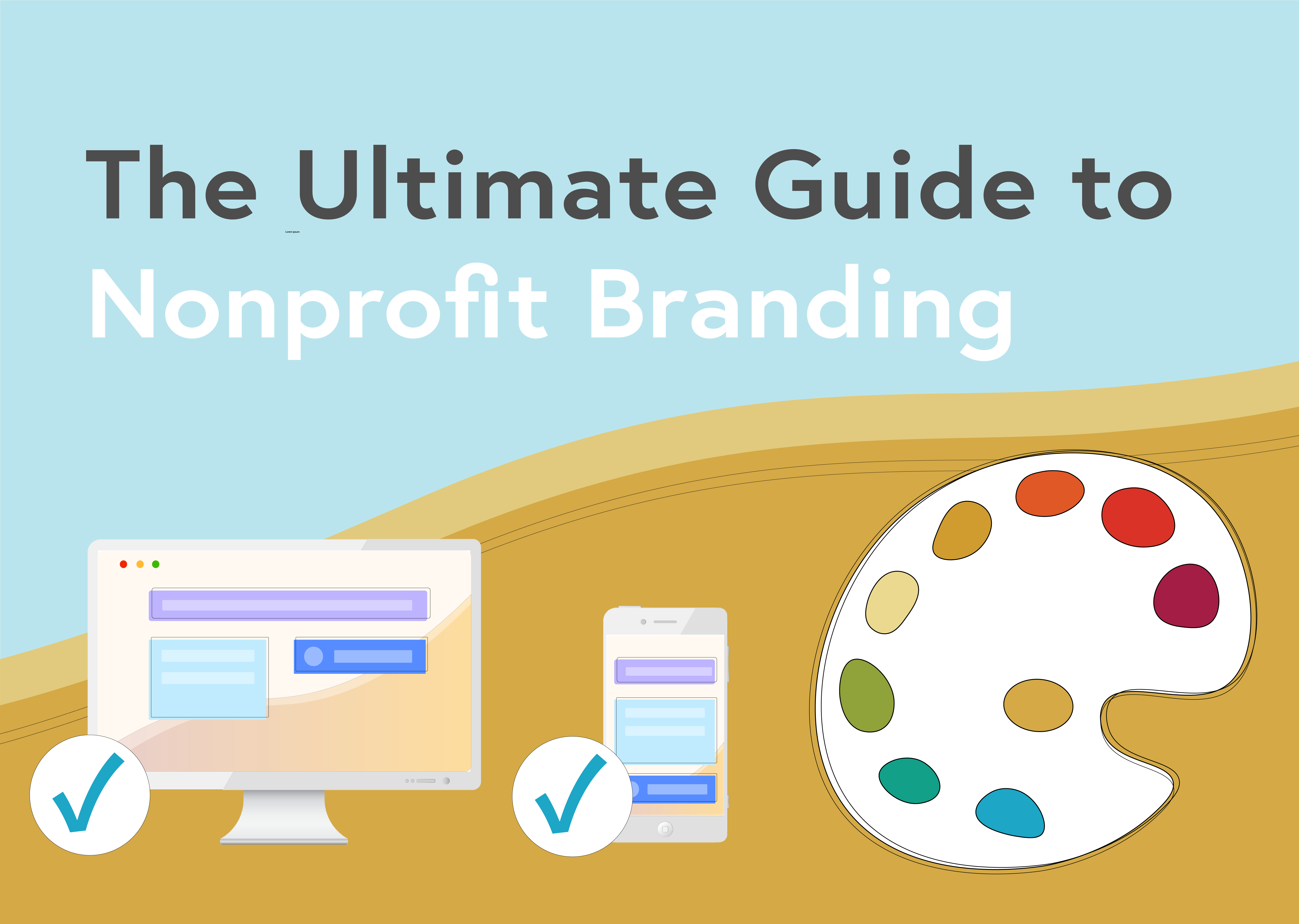
This is a guest post from Alice Corner, a Content Marketer at Venngage.
Chances are you recognize the logos of brands you see every day.
For example, everyone knows Target’s red-and-white bullseye, or the iconic Apple logo.
Their branding is strong and distinctive enough that you may also instinctively trust those brands: you know them, and they’re familiar, so you might be more likely to pick something with their brands than one you’ve never heard of.
And although you might think this kind of brand recognition is only for big companies, the truth is it’s just as applicable to your nonprofit.
After all, you’d recognize the colours and fonts used by the Red Cross or PBS — and to your audience, your materials should be just as recognizable and just as cohesive.
All of this ties into one overarching concept: nonprofit branding.
Branding is, essentially, a way of telling a story about yourself to strangers. Branding your nonprofit boils down to the visual and written way you communicate who you are and what you do. It’s a way to communicate the cause you work towards, and the approach you take towards this cause.
And the story you tell depends on many different factors. The colors you pick can help tell your audience if you’re modern or outdated. A font can show that you’re a caring, hands on nonprofit or a clinical, research-based organization.
Although you might wonder why it’s necessary to focus on branding when you have so many other projects going on, having a strong brand is crucial to distinguish yourself from your competition.
In an increasingly crowded sector, utilizing your brand to tell the best story about yourself possible is one of the easiest ways to differentiate yourself from other organizations in order to attract donations and even top talent.
In both cases, if they buy into the story you are telling about your nonprofit, they can buy into you — just as they would to any business.
Convinced yet?
In this post, I’m going to cover:
- How you can create branding guidelines in 4 steps
- The 4 branding best practices you need to know
- 5 examples of great nonprofit branding to inspire you
How to Create Branding Guidelines in 4 Steps
Brand guidelines are a key part of your nonprofit branding strategy that encompass everything your brand is and wants to be. They should include guidance on design aspects, logos, fonts, and color palettes, but also on what language to use, and how to talk about your nonprofit.
Step 1: Determine the story you want your brand to tell
When developing your nonprofit brand strategy, the first step you need to take is to write down the specifics of what your brand is. This is how you understand the story that you want your branding to tell.
Ask yourself ‘what do we want to be known for’. Try and use descriptive but factual language.
For example, you could be known for being a warm and compassionate nonprofit that helps families in their time of need.
On the other end of the spectrum, you could be a forward thinking, no-nonsense nonprofit determined to fight for families in their time of need.
Both of these represent the same cause, but the language used to describe each is incredibly different. This is where you can begin to differentiate yourself from your competitors.
Step 2: Pick colors and fonts for your brand
Once you understand how you want your nonprofit brand to come across, you can start picking brand colors and fonts that reflect who you are as a brand.
Different colors have different connotations, so you need to pick something that is in line with the descriptive words you developed.
For example, blues and greens are seen as cold, clinical, and clean. They’re also authoritative colors and work well for medical settings. Reds and oranges are seen as warm and friendly colors. If your nonprofit is trying to be seen as ‘caring’ then maybe a blue wouldn’t be appropriate.

It’s a similar story with fonts. Fonts with harsh lines and pointy edges aren’t seen as ‘opening’ or ‘friendly’ as fonts that use smooth corners and flowing lines.
Unicef is the United Nations agency responsible for providing aid for children around the world. They provide humanitarian and developmental aid to children in need, and as such need to be taken seriously.
Their logo is clean and simple, but authoritative. The blue is a calming color, and the smart, simple fonts work well to convey the importance of their work. This logo would have impact in professional spaces and world forums.

But a logo with a different font wouldn’t hold up as well in those professional spaces.
This logo for a children’s nonprofit in Canada uses a child-like, handwritten style font. It pairs the charity name with bold illustrations, and uses multiple colors.
Children’s Wish is a charity that helps make the dreams of sick children come true, and as such having a more child-like, colorful logo works perfectly for them. They feel friendly and approachable.
For Children’s Wish, this logo style and font work perfectly. But for Unicef, this wouldn’t be a suitable font at all. They would look unprofessional and would struggle to be taken seriously in the same way.
Once you understand the story you want to tell with your brand, picking the appropriate colors and fonts will be easy.
Step 3: Build your branding guidelines
One you know how to talk about yourself, you can start pulling together your branding guidelines. You can use a nonprofit branding template to help.
At a minimum, you’ll want to include your company mission statement, what fonts and brand colors people should use, acceptable uses of your logo, and some key descriptive words. These can be the ones you outlined when developing your brand.
Here’s an example from the Red Cross, who summed their branding guidelines up in a one page document that can be easily shared around the organization.

You’ll also need to consider how your brand will translate to different platforms in different ways. For events, you’ll want to have high quality versions of your logo available for banners or other stall branding. On your nonprofit’s website, you have a lot more room for information and design than you would on a social media post. And if you’re doing mail outs you need to have a black and white logo for easy printing.
In the Red Cross example above, different logo styles are outlined for different purposes — the ‘button’ logo being the main one, with the ‘classic’ cross logo being reserved for serious subjects and external comms that require a level of professionalism.
When creating your brand guidelines, you can mind map off of the possible touch points you will have with your audience, and make sure each medium of application is accounted for. Events, website, social media, and various print materials are the main ones, but you might find other uses as you go along.
Step 4: Create a brand kit from your branding guidelines
Once you have these hammered down, you can build a brand kit to ensure consistency of your nonprofit branding across all applications. This is a list of the “rules” of your nonprofit’s brand and instructions regarding how they should be applied, as well as which font to use, which colours represent you, and other key visual attributes. It can also include a selection of pre-created graphics that you can quickly send out to external partners or people on your team whenever the need arises.
This is key because consistency is one of the most important elements of branding — in fact, when brand guidelines are applied consistently across all channels, revenue increases by 23%. Most design tools have a brand kit feature built in to help you apply your brand guidelines to designs easily.
4 Nonprofit Branding Best Practices
More so than other industries, nonprofits need to be considered in their branding in order to make sure that they are presenting themselves in a way that is appropriate for their overall goals. Many nonprofits rely on donations or sponsorships, so it’s important to create a brand that is robust enough for multiple purposes — most commonly fundraising, activation, and impact.
It’s also really important to consider audience buy in when developing your brand identity. Who is the audience you want to appeal to, and how do you want them to think about you?
1. Conduct audience and market research when developing your nonprofit brand
Conducting audience and competitor research is never a bad thing, and can be especially useful to do when you’re creating your branding guidelines. One key question to ask your audience is “What do you expect of us?”
You can also bounce the descriptive words you’ve developed off anybody you interview, to see how they feel about them and whether or not they think they describe your current brand.
Not all audiences will find your brand resonates with them, and that’s ok. But you need to make sure that the audience you want to connect with connects with you.
Checking out what other nonprofits in your space are doing can also help you determine your own identity. Although it’s different than in the corporate space in which you’re “competing” with other brands, knowing what you like about them and what you don’t can help narrow in on your brand’s voice.
2. Take your existing audience and supporters into account
You also need to keep your existing brand recognition in mind when developing your nonprofit branding guidelines. A rebranding can often cause confusion, as your audience will be familiar with your existing brand. This isn’t always a bad thing if you feel your existing brand no longer represents who you are or if you’re trying to reach out to a different audience, but it’s something to consider.
If your nonprofit organization relies heavily on donations or volunteers, you should take into account the opinions of your supporters. People feel loyal to nonprofits they support, so a complete rebrand out of the blue can often feel very alienating.
If you’re planning on a total rebrand, it can be worth considering conducting some supporter surveys or focus groups early on in the rebranding process. This way your supporters will feel involved in the progression of your nonprofit brand, and you will gain some valuable insights from your biggest fans.
3. Use case studies and success stories within your branding
Showcasing the real stories behind a cause can be invaluable. If you have strong case studies or brand advocates, make sure you find a way to include them in your branding. This doesn’t mean put them on the logo, but create a format of marketing that involves them. Using a visual storytelling approach to build a brand can be a great way to help build emotion that resonates with audiences.
For example, Young Women’s Trust offers career coaching and resume services for young women in the UK, and makes testimonials a major part of their online branding.
For audiences who are typically defined as ‘hard to reach’, hearing about the success of others can be a big motivating factor in engaging with a nonprofit. It can also be an influence on your supporters, seeing that their money and time is actually making a positive impact.
(PS: this is also a great tip to keep in mind when you’re putting together your nonprofit’s annual report!)
4. Use infographics to help visually communicate your impact
Infographics are also a great way to communicate complex ideas simply. The crux of good nonprofit marketing is ‘we have problem X — we need you to take action Y’ and with a nonprofit infographic, you can visualize impact easily.
For example, you can communicate the scale of the problem you’re trying to solve, or what difference a donation can make through icons within the infographic to help tap into the emotional side of your branding. You can also use list or mind map formats to showcase the full extent of your work — and then easily share them across social platforms and your website.

5 Strong Nonprofit Branding Examples to Inspire You
Ready to get started and create your own brand guide? Here are some examples you can check out to make it the best it can be!
1. Cancer Research UK
Cancer Research UK are known for their strong and distinctive branding that they use consistently across channels and mediums. They use the visual motif of circles in their logo and across all of their designs.
This circle motif helps distinguish them from other nonprofits, and means that their graphics are instantly recognizable. The color palette is fairly muted, but still feels warm and friendly despite the use of the blue, like we can see in this example:

2. Camp Ooch
Camp Ooch also makes good use of visual motifs in their branding, though in a much more subtle way. To reflect the nature of their work, a summer camp for children affected by cancer, blob-like shapes, soft, childish lines, and bright colors are used throughout their materials.

In the above nonprofit branding example, the use of testimonials from Ooch Campers alongside these shapes, and powerful photography really helps bring home the emotional element of the work the nonprofit does. While the website doesn’t look unprofessional or childish, it does look child-like, which is perfect for their branding.
3. SickKids
Another nonprofit that works in the childhood illness space is SickKids, but their branding couldn’t be further apart. Whilst Camp Ooch wants to give children memorable experiences, SickKids is a research hospital that aims to improve the health of children. As such, their branding is much more authoritative. They make use of more ‘clinical’ colors, like blues and greys.
The shapes and lines they use are a lot sharper too, in contrast to Camp Ooch, in order to continue building their authoritative voice. They also use language that is powerful, like their ‘SickKids VS Impossible’ campaign.
4. Oxfam
In a completely different space, we have Oxfam, who are known for their great and innovative branding. The color green here is used to show Oxfam’s commitment to ending global inequality, but is also a fairly warm green and makes the charity feel friendly and approachable.
The lack of hard lines helps add to that friendly feel, and the playful fonts help show this too. Oxfam uses strong case stories and photography to ensure that their impact is always front and center.
5. Help Refugees
Another charity that brings the human element into their branding is Help Refugees, and specifically their Choose Love campaign. Aimed at encouraging people to donate money, the Choose Love campaign is an offline and online store that lists various items that the charity needs, with the cost of each item.
By rooting their branding in a message of hope and love, the charity is incredibly successful at creating an emotional response from their audience. The colors are modern and slick, and the entire brand mimics a high fashion or lifestyle concept store, helping appeal to the millennial donation audience.
Each nonprofit brand will be completely different depending on the cause, approach, and audience. For this reason it’s hard to say how to brand, or how not to brand your nonprofit. But if you follow the steps to discover what your brand is and how it feels, you’ll be able to build a robust and fitting brand!




